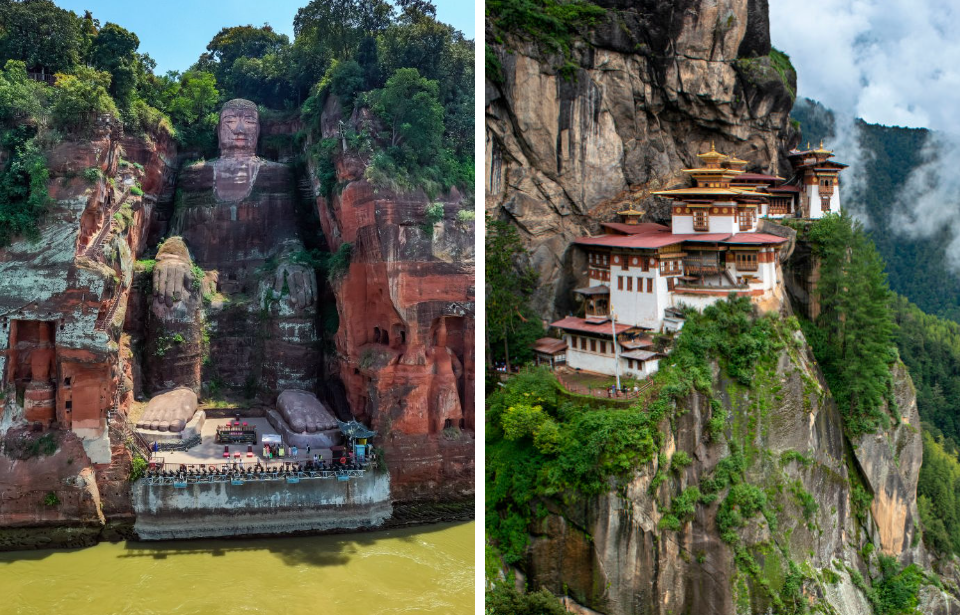There is no shortage of stunning structures created by the ancient people of the world. From the pyramids of Egypt to the Great Wall of China, they have certainly stood the test of time. Yet some people built their incredible structures in a very different way. The ingenuity of ancient societies can be seen in how they expertly constructed buildings and statues out of existing natural rock faces and cliffs.
Cliff Palace of Mesa Verde
Located in Mesa Verde National Park in Colorado, United States, the Cliff Palace is the largest dwelling of its kind in North America. It was built by the Ancestral Puebloans in their traditional homeland. Researchers date the site to roughly 1190 CE when construction first began. It was carried out until 1260 CE when a total of 150 rooms had been built.
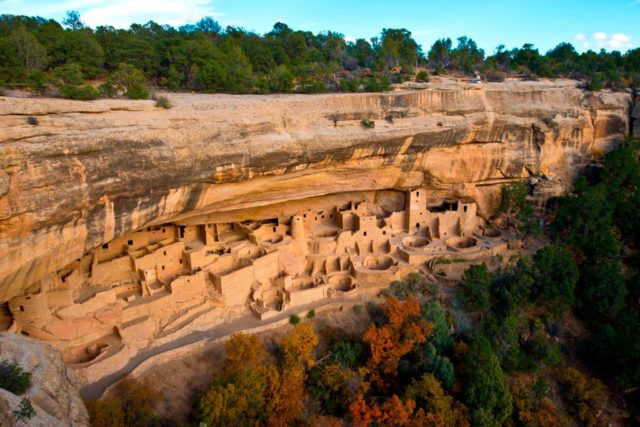
The Cliff Palace was built in response to changing environmental conditions which caused increased competition for resources in the region. By 1300 CE, however, the site was completely abandoned. The cause for desertion is unknown but it was likely due to terrible droughts making it difficult for the Puebloans to grow food. The site was discovered in 1888 when two farmers were out looking for some missing cattle.
Necropolis of Pantalica
The Necropolis of Pantalica is a UNESCO World Heritage Site located in Sicily, Italy. It is a large cemetery consisting of 4,000 rock-cut tombs, although it was once believed that there were over 5,000. Pantalica technically covers two separate sites at a distance of 50km from each other, but UNESCO considers them one single site.
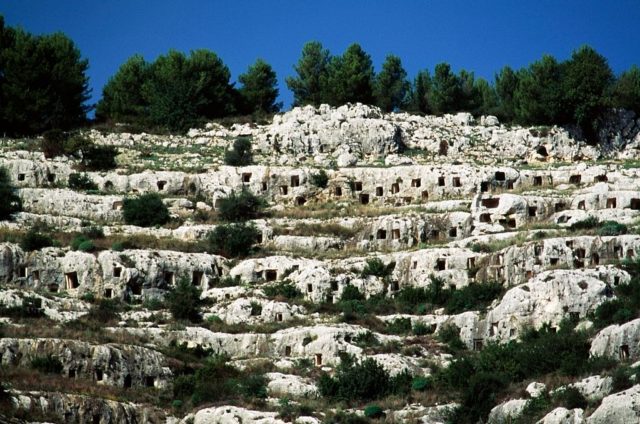
At the top of one hill is the “Prince’s Palace,” Anaktoron, a Mycenaean multi-room building, and some remains of other small rock-cut houses. Construction of the site occurred tooka long time, between the 13th and 7th centuries BCE. The site was used by different societies.
Cliff of Bandiagara
Unlike many of these ancient constructions, the Cliff of Bandiagara is still inhabited – though not by the people who first built it. The escarpment in Mali is a sandstone cliff that measures 1,600 ft tall and 150km long. It was originally occupied by the Tellem and Toloy people. The structures from the former remain and were listed as a UNESCO World Heritage Site in 1989.
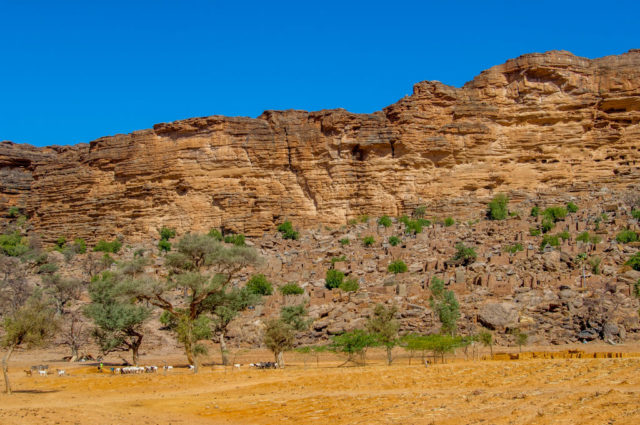
The Tellem had numerous uses for the cliff. They used to live on the slopes. They also carved many caves into the rock face which they used to bury their dead at a level that would stop them from being washed away in flash floods. Now, the area is home to the Dogon people. From roughly the 15th century CE onwards, the Dogon used the area as a defensive fortification to protect themselves from invaders in the region.
Paro Taktsang Monastery
The ornately designed Paro Taktsang Monastery, also known as the Tiger’s Nest, is located 3,120 m above sea level in one of the Paro Valley cliffs in Bhutan. The Buddhist temple was formally constructed in 1692, although the site was used as a meditation cave as early as the 9th century CE. It was one of 13 areas said to be used by the Buddhist master Padmasambhava. The structure is difficult to reach, one of the reasons a fire in 1998 burned it down.
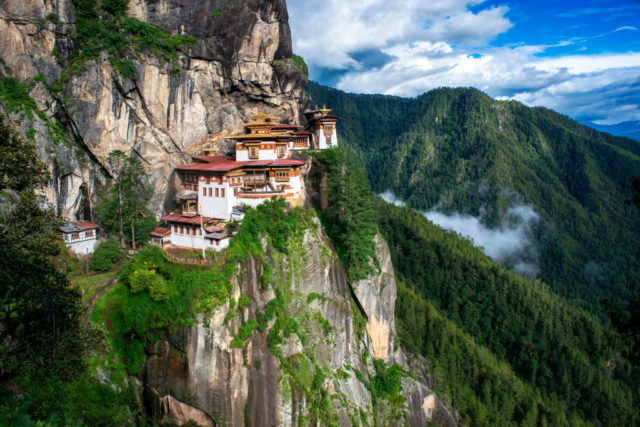
It was eventually restored with financial help from the government in 2005. While the monastery might look like any other building from the outside, the inside contains eight caves that are used by the monks who live there. Four of the caves are relatively easy to access, while the others are much more difficult. The monks are each supposed to live and meditate in the caves for three years.
Sarcófagos de Carajía
The Sarcófagos de Carajía were built by the Chachapoyas, “Warriors of the Clouds.” They were a society that lived in what is now Peru before being conquered by the Inca Empire in the 16th century CE. The “ancient wise men,” as the sarcophagi have been called by locals, can be found on a cliffside in the Utcubamba Valley. The site once contained a total of eight sarcophagi, until one was destroyed during an earthquake.
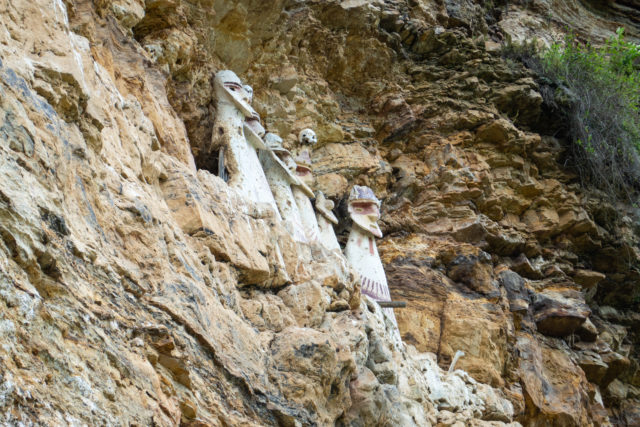
To protect their dead, the sarcophagi were placed in areas that were difficult to access. While not the only discovery of this type, the Sarcófagos de Carajía are special as they remain mostly intact and stand over over two meters high. Although they were built in the 15th century CE, it wasn’t until the 19th century CE that researchers were able to finally investigate them.
Sumela Monastery
Deep within the Pontic Mountains in Turkey, 1,200 meters high on a cliff, sits the Sumela Monastery. The exact date of construction of the building is not known, although the Turkish Ministry of Culture and Tourism says that it was founded in 386 CE by two Athenian monks – Barnabas and Sophronios. It is now considered one of the most important tourist and historical sites in the area, but that didn’t stop it from being abandoned many times throughout its history.
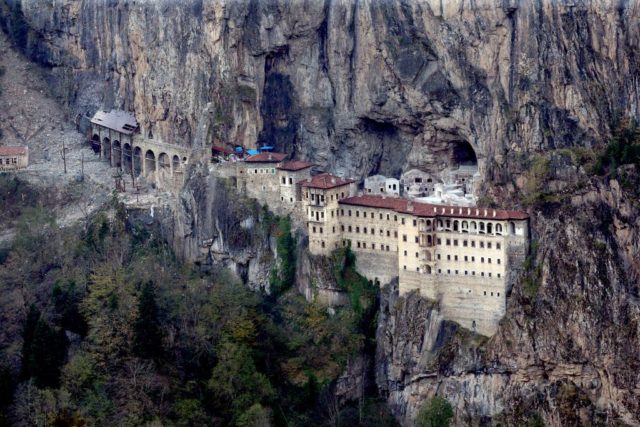
It was restored and expanded by various emperors and generals before it became what it is today in the 13th century CE. It’s still an extremely popular place to visit as it is now a museum. Due to rock slides in 2015, it was closed to the public before being reopened in 2019. The Sumela Monastery is one of the oldest Christian monasteries although it is no longer in a Christian country.
Hanging Monastery of Mount Heng
The Hanging Temple or the Hanging Monastery of Mount Heng is built into a cliff 246 ft above the ground in Shanxi Province, China. It was built over 1,500 years ago and is still one of the most important historical sites in the Datong area. While part of its allure comes from its location on the cliff, it’s also the only temple to honor deities of Buddhism, Taoism, and Confucianism concurrently.
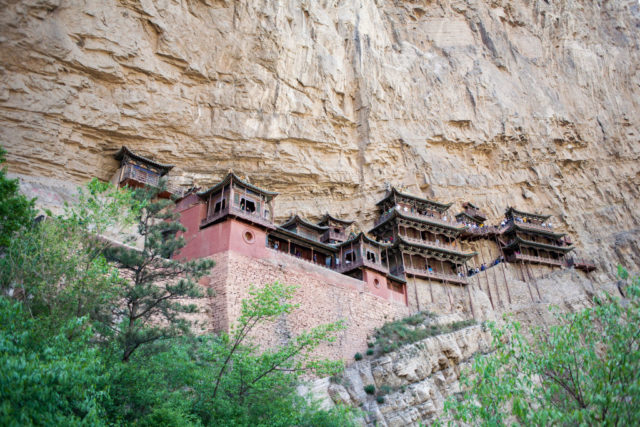
Statues of these deities can be found in the Hall of Three Religions. Despite the “hanging” nature of the building, it has been well protected by the peak of the mountain which blocks out much of the sun, rain, and snow that could have brought a quick end to the monastery. The interior is made up of six large halls and 34 smaller halls which are connected by a maze of passageways.
Leshan Giant Buddha
Listed as a UNESCO World Heritage Site in 1996, the Leshan Giant Buddha was carved out of a red sandstone cliff located at the intersection of the Min and Dadu Rivers in China. It was built between 713 and 803 CE, and at 71 meters is the tallest stone Buddha in the world, as well as the largest.
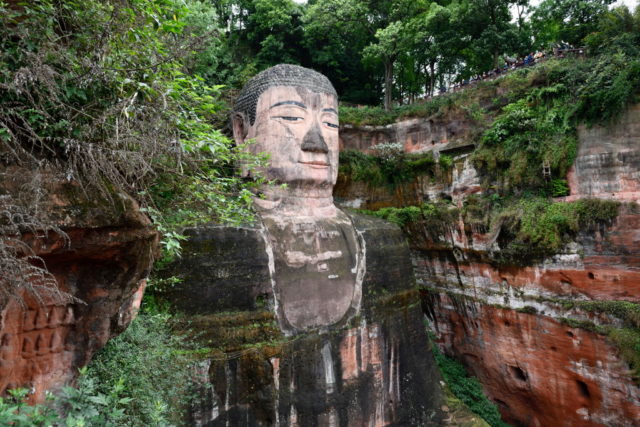
It has suffered wear and tear in the years since it was built, predominantly from environmental factors. It was initially given partial protection from the elements by a wooden structure but it was destroyed by the Mongols and never rebuilt. Moss covered the statue, contributing to the degradation but it’s been reconstructed over the years to help compensate.
Longmen Grottoes
The Longmen Grottoes, or the Dragon’s Gate Grottoes, are located in Henan Province, China. They are home to tens of thousands of statues depicting Shakyamuni Buddha and many of his disciples. The exact number of statues isn’t known, but it is believed that there could be as many as 100,000. Most are located inside the 2,345 caves that were excavated in limestone cliffs.
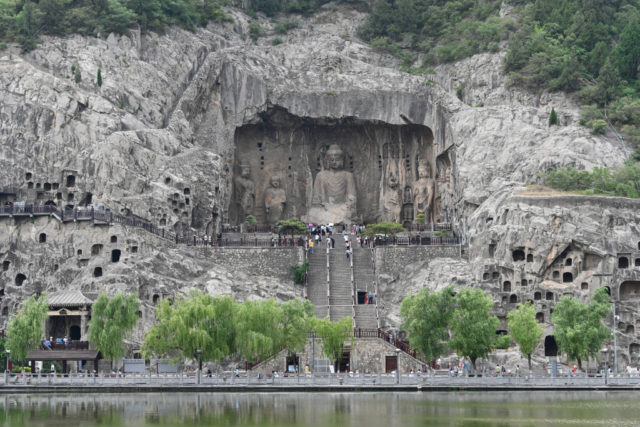
The caves perfectly showcase the intricacies of ancient Chinese stone art, while also providing a window into the cultural, political, and artistic views of the Wei and Tang periods. It took nearly five centuries to construct them, beginning in 493 CE. The most notable of the caves include Guyang, Fengxiansi, and the North, Middle, and South Binyang Caves.
Lycian rock-cut tombs
The Sumela Monastery isn’t the only popular cliffside construction in Turkey. Unlike the monastery, the Lycian tombs were actually carved into the side of the mountain. The exterior of the carvings are extremely ornate and detailed, unlike the insides which are simple and functional. The tombs were specially created to honor the tradition of the afterlife that the Lycians believed in.
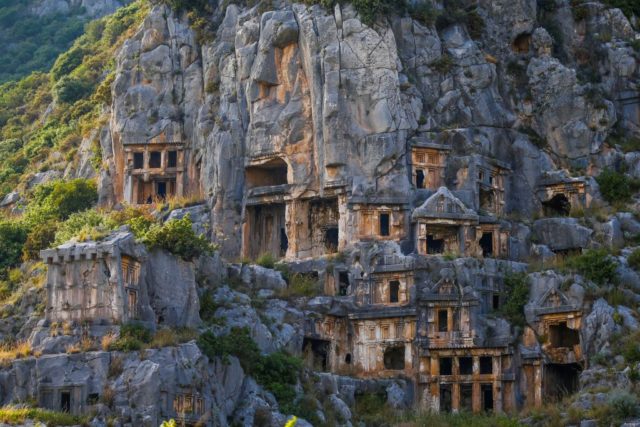
They thought that their dead traveled on the backs of magic winged created so they placed their remains in areas that were high up. These tombs were reserved for the Lycian kings and queens. Tomb construction dates to the 4th century CE, but there were many earlier tombs that were much more simplistic in style.
Puente Nuevo
Spanning the 120m deep chasm of the Guadalevín River, the Puente Nuevo, or New Bridge, was fully constructed by 1793 in Ronda, Spain. It was designed by José Martin de Aldehuela and built by Juan Antonio Díaz Machuca. Before this bridge was built a previous attempt was made to span the gorge, resulting in a collapsed bridge and the death of 50 people in 1741.
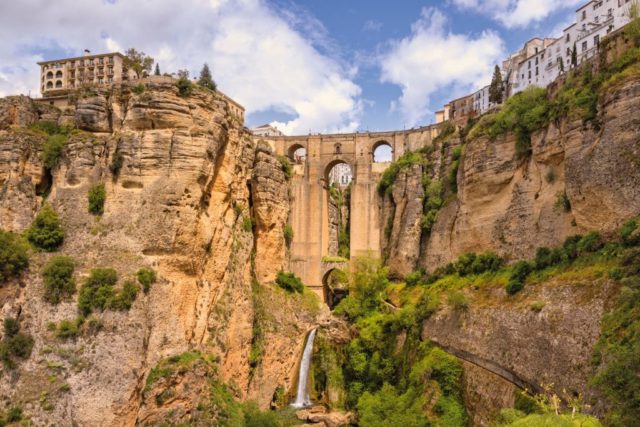
The second attempt, the Puente Nuevo, had multiple purposes as there was a chamber built into the central arch. This was most famously used by both sides during the Spanish Civil War as a prison and torture chamber for captured opponents. Allegedly, some of these prisoners were killed by being thrown out of the chamber window.
Ellora Caves
The Ellora Caves are one of the largest rock-cut Hindu temples in the world, earning the title of UNESCO World Heritage Site in 1983. They are located in the Aurangabad district in India and are a mix of monasteries and temples. Ellora spans more than two kilometers in length with monuments varying in construction dates from 600 to 1000 CE. The caves represent a variety of different religions including Hinduism and Buddhism.
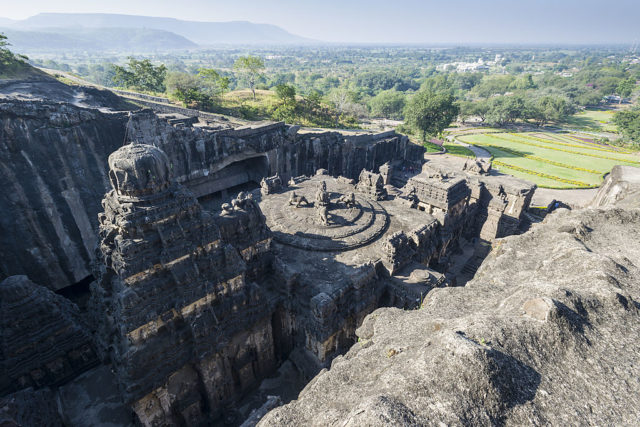
More from us: Lester Became a Ghost Town When Its Last Resident Died at the Age of 99
This was done purposefully as a result of the religious harmony of ancient India. There are 100 caves at the site, which were excavated from the basalt cliffs in the area. Of these 100, only 34 are open to the public. Cave 16 is particularly special as it contains the largest single monolithic rock excavation in the world. It is a Kailash temple that was dedicated to Shiva.
